From WordPress to Ghost: Reflections on a Fresh Start
I used WordPress for nearly 20 years. Now I’ve switched to Ghost, and it’s changing how I write online. This is the story of my move: what worked, what didn’t, and why the move matters.

In January 2025, after over two decades of writing online – nearly all of it using WordPress – I decided it was time for a significant change. WordPress has been the foundation for my online presence since 2004, and it is a reliable platform that has served me incredibly well over the years.
Yet, something had gradually shifted. Big rifts have appeared in the WordPress firmament. The complexity of the platform and how to use it just for blogging increased. The rise of microblogging and social networks changed the landscape. The overall experience of writing, publishing, and engaging online had evolved, and I felt a growing need to simplify and refocus.
Additionally, for quite some time, I realised I was spending more time as a site admin than as a writer. Running a self-hosted WordPress site meant handling platform updates, plugins, themes, security, and receiving constant sales pitches and marketing messages, as a matter of routine.
But what used to be enjoyable had become exhausting.
What This Post Covers:
- Why I Thought About Moving to Ghost
- Weighing the Pros and Cons of Moving
- Why I Chose Not to Migrate Everything
- Deciding to Make the Move
- The Experience of Launching Nevillehobson.io
- What I've Learned and What's Next
- Closing Thoughts and Resources
Why I Thought About Moving to Ghost
Over the past few years, I'd become increasingly aware of how the act of writing and publishing online had transformed. Readers' expectations had evolved, too, favouring clean, fast-loading, distraction-free reading experiences.
I began noticing other writers and creators adopting platforms that emphasised content quality and clarity over extensive customisation or complex features. I saw the rise of newsletters led by Substack, Beehiiv and others.
Ghost caught my attention precisely because it was designed for writers, publishers, and others who want to share their thoughts and build and engage with a community. Hosted Ghost promised a simpler, more streamlined workflow – exactly what I sought. The appeal was clear: less maintenance, fewer distractions, improved performance, and a reader-friendly aesthetic.
Additionally, Ghost's built-in newsletter and subscription tools offered an enticing opportunity to engage directly with readers without relying on multiple external services or complicated integrations. I was increasingly drawn to the idea of reducing complexity and prioritising clarity, both for myself and for my audience.
I was also keen to be part of a grand experiment with ActivityPub, an open protocol that powers federated networks like Mastodon on the so-called fediverse. Ghost supports this natively via the public beta of its social web functionality, announced in early March. This means that every Ghost Pro site is a potential node in a broader interconnected ecosystem, allowing posts and interactions to flow freely across multiple platforms. I'll post more about this in the future.
Then, there was the matter of content bloat on my WordPress site. It contained over 4,000 posts and pages, representing my collective output over nearly 20 years. The site itself had become layered with platform updates, plugins, themes, tweaks, and years of tinkering. There's also a separate archive covering the period 2002-2006 with more than 1,400 posts. Trying to unravel all of that complexity for a clean start was a daunting prospect.
Ultimately, moving to Ghost aligned perfectly with my desire to refocus on the fundamentals – writing clearly, engaging genuinely, and sharing ideas effectively – and the future, without the platform overhead I'd previously accepted as unavoidable.
A shift to Ghost isn’t just a technical migration; it’s a philosophical one. It’s about stripping away the noise and focusing on what truly matters. I’m looking forward to rediscovering the joy of publishing without the baggage of managing a complex website. Ghost Pro feels like the perfect partner for this new chapter.
Weighing the Pros and Cons of Moving
Moving from self-hosted WordPress to hosted Ghost was not a decision I made lightly. It required careful consideration, assessing both the clear benefits and the significant trade-offs involved.
✅ Pros
- Simplified Workflow: Ghost’s user-friendly interface enabled me to focus solely on writing and publishing, without the distraction of extensive site administration.
- Built-in Newsletter and Subscription Features: Ghost provides integrated tools for managing newsletters and free/paid subscriptions directly within the platform. This integration eliminates the need for additional plugins or external subscription services.
- Performance and Speed: Ghost sites typically load faster and perform better than their WordPress counterparts, significantly improving the reader experience.
- Minimalistic, Reader-Focused Design: Ghost’s modern and minimalist themes aligned closely with my vision for a distraction-free reading environment.
- Cost-Efficiency: Ghost Pro’s managed hosting ($300/year for the Creator plan, around £230) save me at least £100 annually compared to SiteGround where I've been with my WordPress sites for some years, plus additional savings by eliminating several premium WordPress plugins.
❌ Cons
- Migration Complexity: With over 4,000 pieces of content built up over the years, the complexity of migrating content was substantial. Ghost doesn’t support importing and re-hosting images from WordPress in the same way, which meant I would need to handle them manually. Shortcodes and formatting also needed extensive adjustment.
- Continuing Costs for WordPress Hosting: I still needed to pay for hosting my WordPress archives, though I reduced costs significantly by moving the archives to Hostinger.
- SEO Risks: Shifting to a new domain and platform risked losing SEO authority. 301 redirects help, but there was still a real risk of visibility loss.
- Reduced Customisation: Ghost offers fewer customisation options than WordPress, especially on the hosted version. Advanced functionality requires workarounds.
- Media Management Constraints: Ghost lacks a media library like WordPress, so image handling needs extra care.
After evaluating these factors and experimenting with Ghost's free trial, I recognised that the clarity, simplicity, and refocused purpose Ghost offered outweighed all the downsides.
Still, I knew careful planning and clear communication with my audience would be essential to mitigate potential issues effectively. Rather than bombard readers with email updates, I mainly relied on cross-posting my content from the WordPress site to the embryonic Ghost site and amplifying the WordPress posts across social networks.
The Ghost site was private at that stage, but I gave access to a handful of people who requested it. Their feedback, mainly on the look and feel of the site and of the email newsletter, was helpful.
Why I Chose Not to Migrate Everything
Initially, my plan was to migrate all my existing content from WordPress to Ghost, retaining my established domain, nevillehobson.com. This approach promised brand continuity, preserved SEO rankings, and maintained familiar access for readers.
However, a deeper technical evaluation led by Jon Hickman, Ghost's support lead, highlighted significant challenges, especially around images and content formatting. My WordPress posts contain thousands of images, nearly all of which are hosted across WordPress’s content delivery network. Ghost, however, doesn't natively support importing and re-hosting these images in the same way. The prospect of manually relocating or individually correcting images across thousands of posts was neither practical nor appealing.
Additionally, formatting and compatibility posed substantial problems. WordPress-specific features such as shortcodes and custom formatting elements would not transfer neatly into Ghost. This mismatch could lead to significant inconsistencies and require extensive manual intervention to correct, defeating the purpose of simplifying my publishing experience.
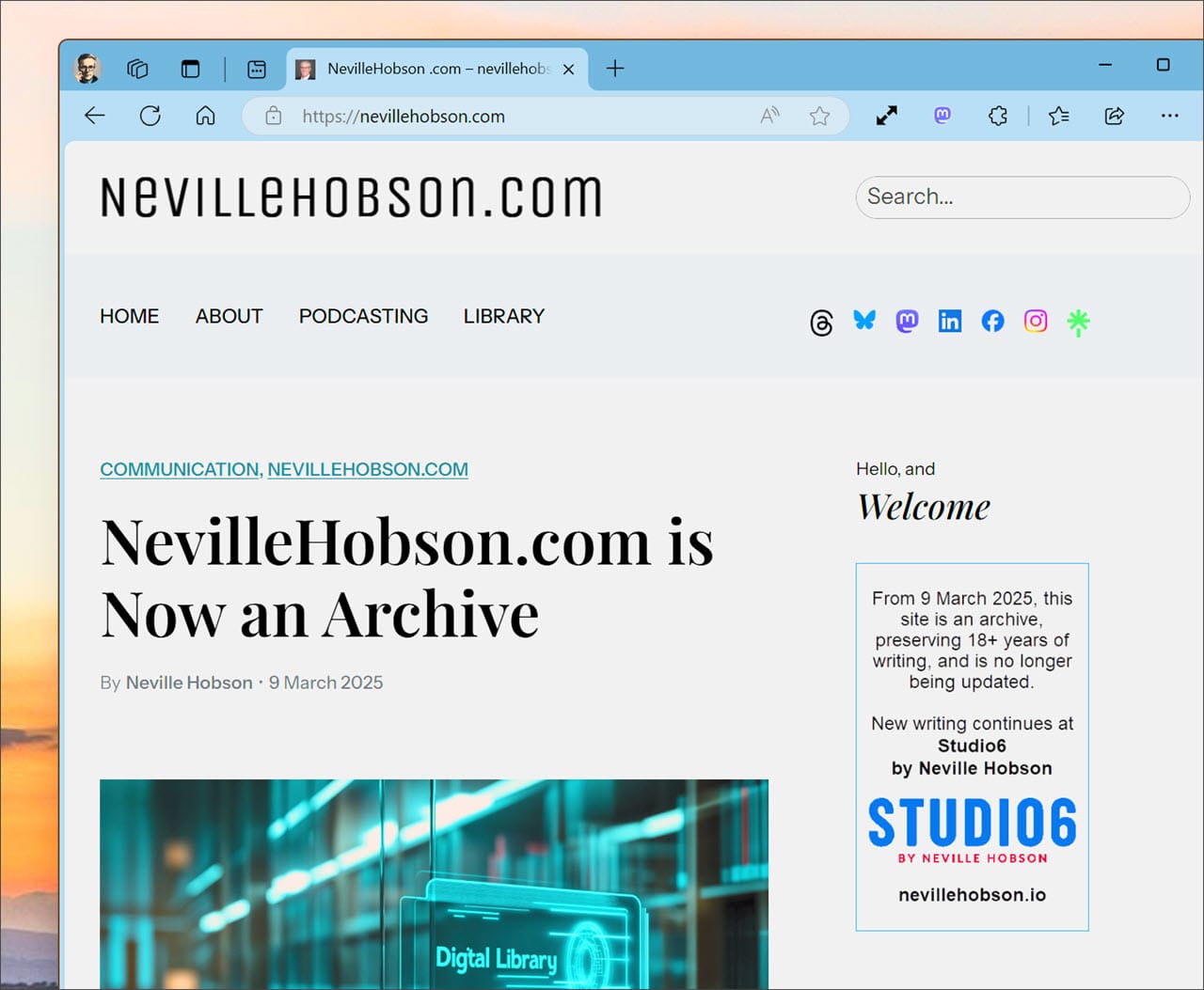
Fixing all this required complex manual intervention and custom scripts. Jon's tech skills are impressive, and his willingness to find solutions is outstanding. For example, he resolved a major issue resulting from a tweak on the WordPress site some years ago that required a plugin there to prevent duplicate featured images being included in posts. Without that resolution, it would have meant manually editing every post, or accepting the UX-killing notion of duplicate or broken images everywhere.
These migration hurdles risked undermining my primary goal: simplicity. Instead of reducing site management, migrating all content would create substantial ongoing administrative burdens. I also considered potential SEO impacts. And, while full migration preserved domain continuity, any unresolved content issues could result in wide-scale 404 errors and seriously damage user experience and search rankings.
And there was a significant additional factor – the site bloat I mentioned earlier. If I migrated the WordPress site and all its content, I'd be bringing along all the historical baggage from the almost two decades of WordPress installs and updates, plugins, themes, etc. No thanks!
I felt that attempting a full migration of all content, complete with redirects and SEO preservation, would involve complex processes with no guaranteed success, and clearly undermine the fresh start I was seeking.
Ultimately, I concluded that a fresh start, leveraging a new domain, a new name and Ghost’s minimalist but powerful native features, offered a cleaner, simpler transition. By leaving my original WordPress site online as an archive at nevillehobson.com, I could preserve valuable historical content and SEO benefits, and avoid complex migration issues. Meanwhile, the new site at nevillehobson.io would allow me to fully embrace Ghost’s simplicity and a refocused publishing philosophy without legacy constraints.
This strategic choice balanced practicality, audience clarity, and the genuine fresh start I desired.
Deciding to Make the Move
And so, after thoroughly evaluating the pros and cons, I reached a point where the decision to move, not migrate, felt both exciting and inevitable. The appeal of focusing purely on writing, publishing, and direct audience engagement far outweighed the challenges of transitioning the WordPress site into a Ghost one.
My initial exploration with Ghost Pro’s free trial significantly influenced my decision. Testing a Ghost Pro Creator account hands-on allowed me to confirm its ease of use, elegant simplicity, and streamlined publishing workflow. This experience convinced me that Ghost could truly reduce complexity and improve both my writing process and reader experience.
And the new name, "Studio6"? Part of my thinking was to have a name, a brand, instead of just my own name. That would signify the shift I wanted to something separate, not just me. But it needed to maintain a connection with my name that would make the transition from .com to .io simpler to see. Hence, "Studio6 By Neville Hobson" is the full name.
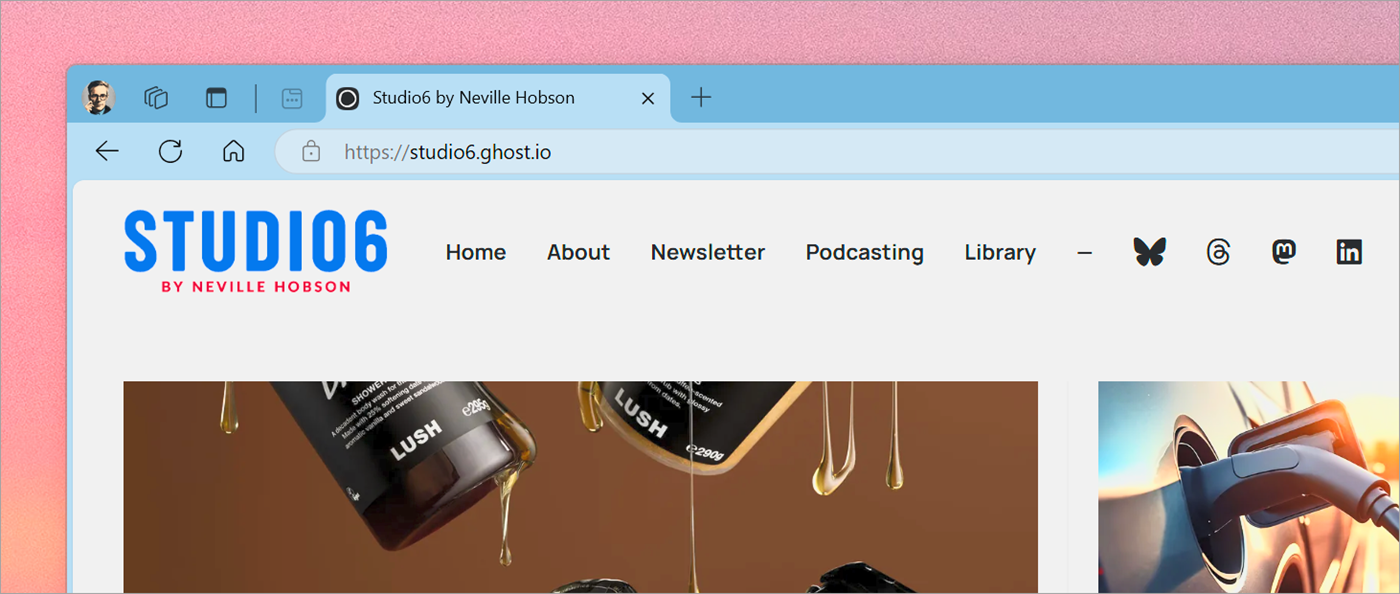
"Studio6" is a reflection of actual workspaces that have made major impressions in my life, both professional and personal. Studio6 is the sixth such workspace and, as a garden studio, the first of its type.
The original go-live date was planned for the end of February. It was an arbitrary date, not based on urgency or meeting some deadline. The date shifted a bit due to some last-minute completions, and the switchover happened on Sunday 9 March.
The Experience of Launching Nevillehobson.io
Launching Studio6 By Neville Hobson at nevillehobson.io was both exciting and enlightening. Having decided to start afresh, I approached the process with a clear vision of what I wanted my new site to achieve: simplicity, speed, and a seamless user experience.
From the launch post:
Why the change? It’s about simplifying, refocusing, and creating a space that prioritises meaningful conversations over algorithms. (Read more in the About page.) Studio6 represents a fresh start – a place where I can write and connect with readers, both here and through a new newsletter, in a way that feels more intentional.
The initial setup with Ghost Pro was straightforward and intuitive, aligning perfectly with my goal to simplify the publishing workflow. Selecting a minimalist, reader-friendly theme was a priority, and Ghost's own range of free themes offered precisely the aesthetic I had envisioned.
To start, I'm using the attractive and free Source theme. The customisation options were sufficient to ensure my branding felt personal and distinct without overwhelming me with complexity. I plan to stay with this through much of this year, perhaps longer.
That said, this is a different platform from WordPress, and some things in the content creation process are quite different, which takes a bit of getting used to – in a good way.
The default editing view is a clean canvas, so to speak, with no distractive elements. Yes, you can have something similar with WordPress, but it doesn't feel similar within the block-editing system on that platform, nor as natural.
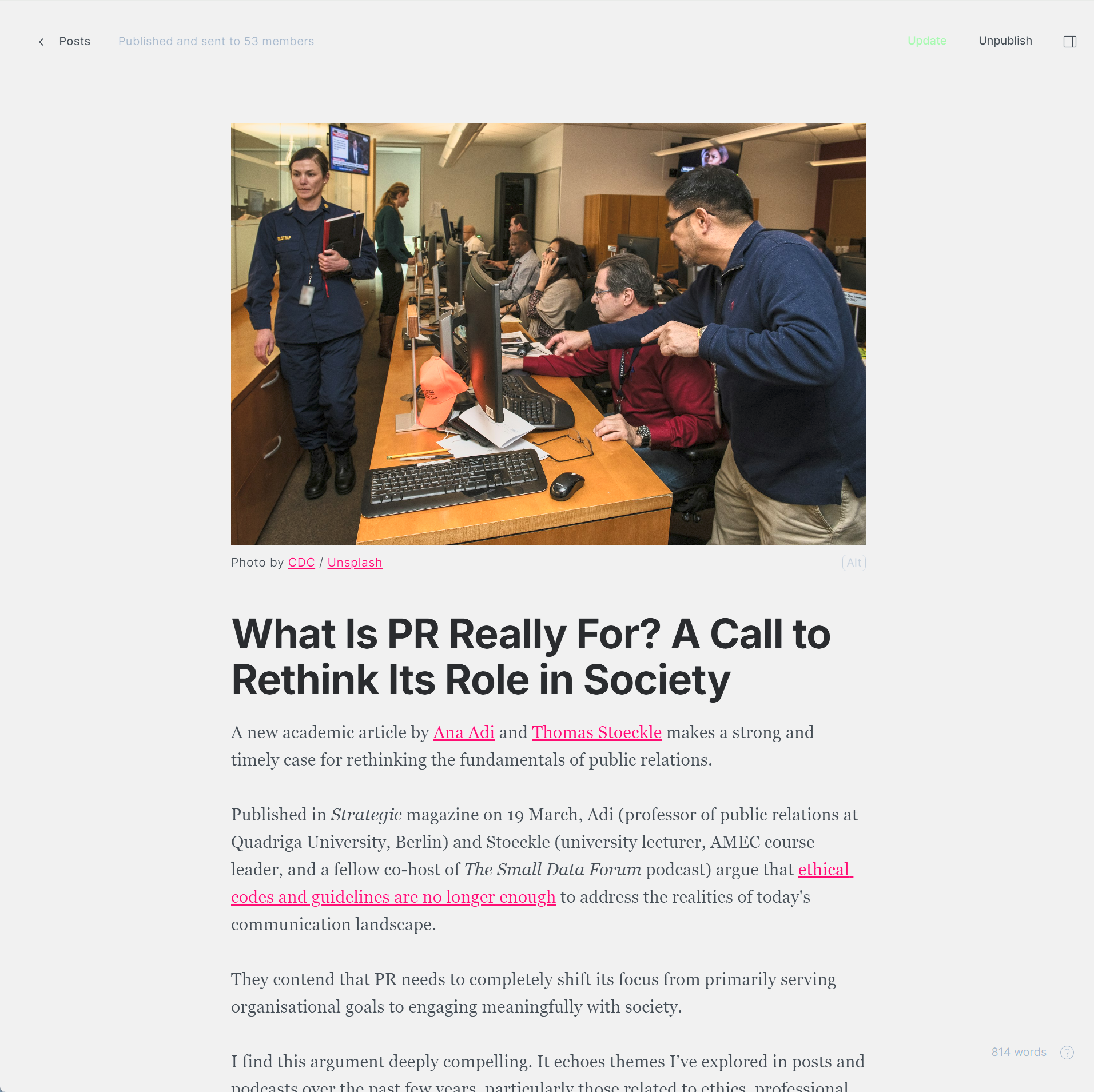
I find this clean and fresh-look approach exactly what I want and like. It really is distraction free.
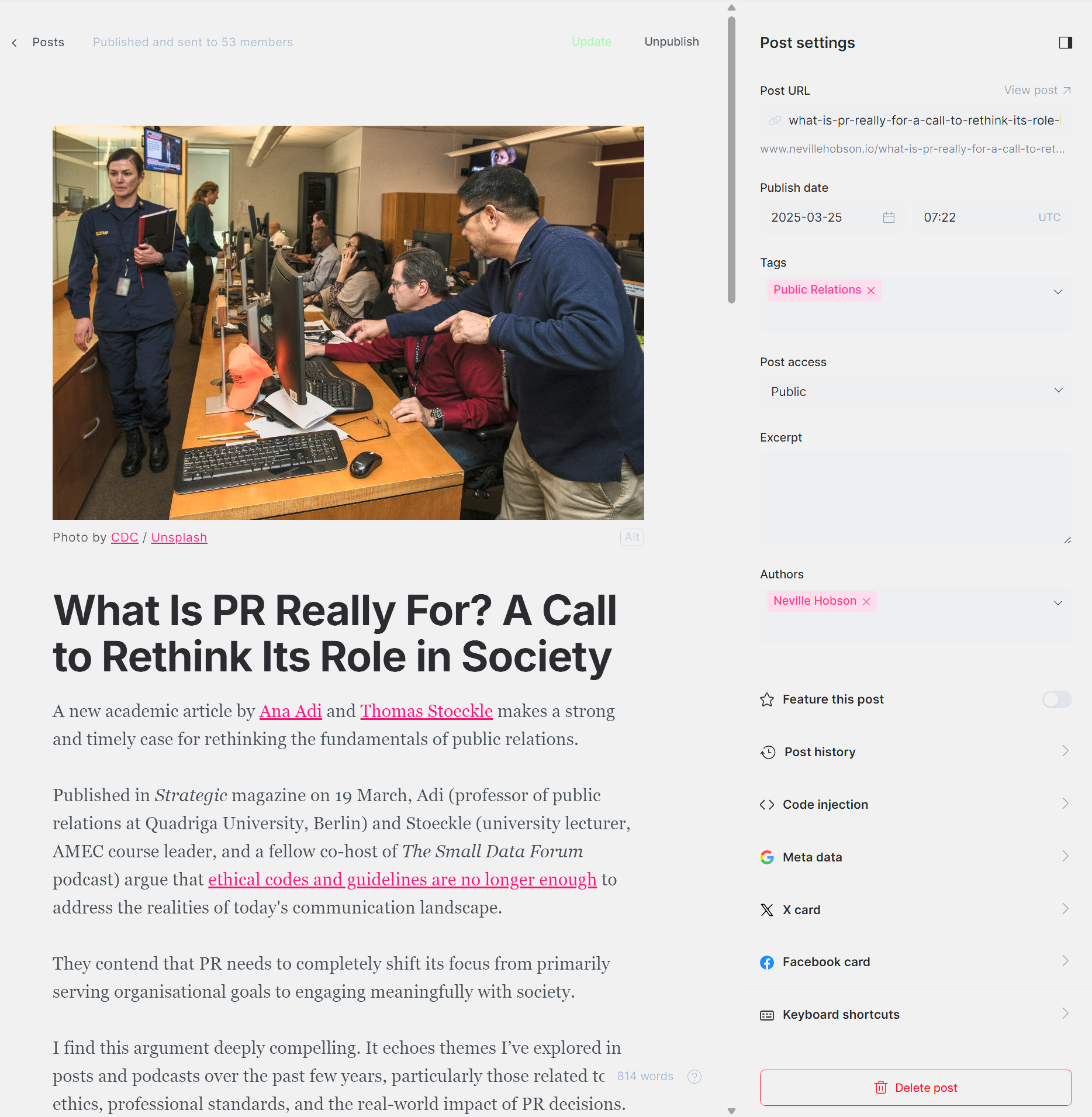
Posts are much more closely integrated with a newsletter than is the case on WordPress. I made my newsletter free to access and read, and I don't offer a paid option. Once I'd set up the features and appearance of the newsletter emails, there wasn't much else to do other than write and publish a post, which then automatically sent it out to subscribers.
Within my Ghost site dashboard, I have an analytics reporting function that lets me see metrics such as who opened the email, who clicked on what link in the email, feedback from the email. Remember, the email is the newsletter.
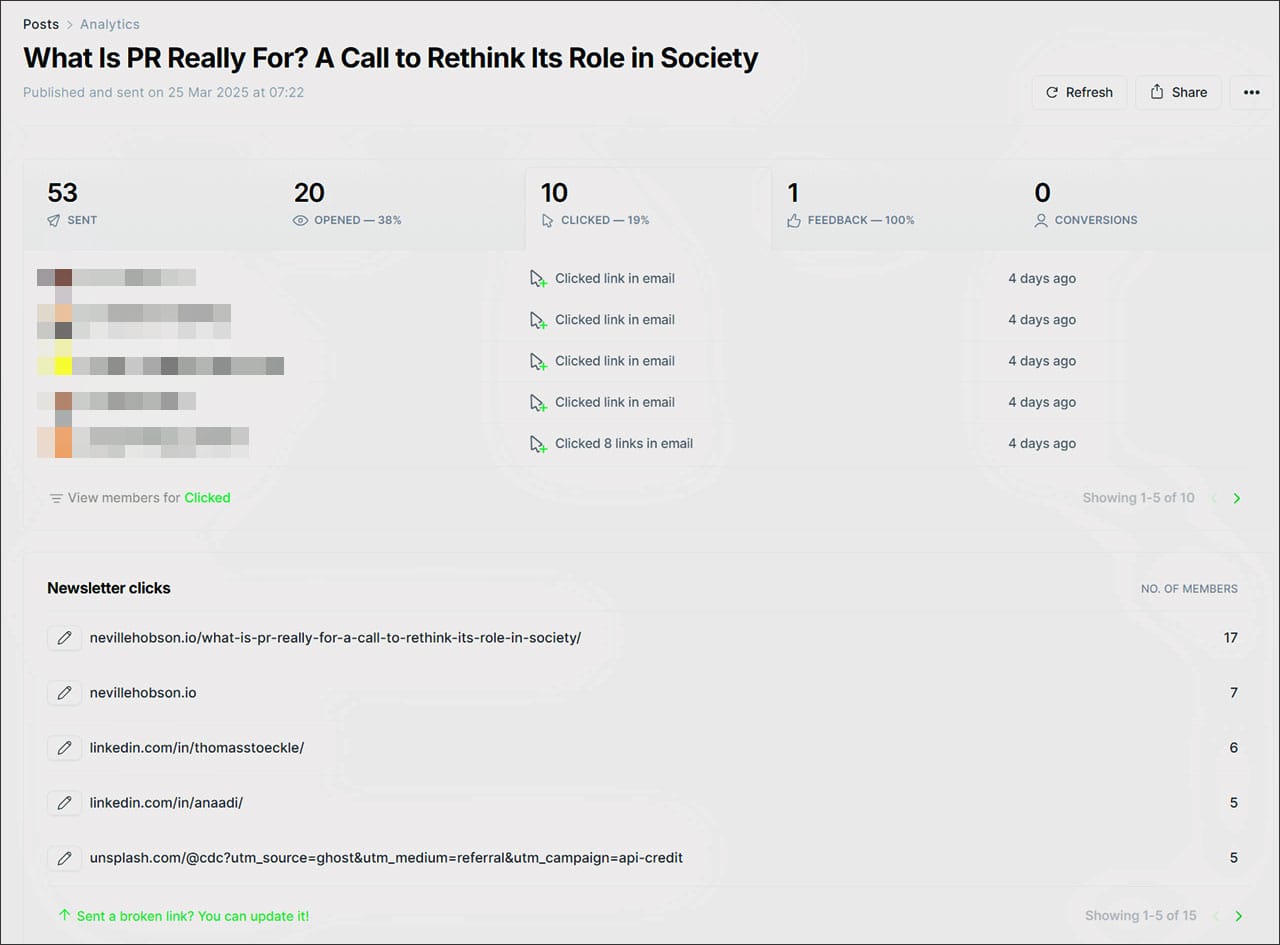
As I published my first few posts, including a symbolic "A New Beginning" post on 1 January, it quickly became evident to me that Ghost delivers on its promises. The platform allows me to focus purely on writing and audience engagement without the distractions and frustrations of site management.
Performance improvements were immediately noticeable, with the new site loading faster and delivering a superior reading experience compared to my previous setup. Arguably, that's a subjective view, but it is clear that a site without the burden of so many add-ons like plugins is very likely going to be a better performer.
Throughout the launch process, support from the Ghost support team was exceptional. Their responsiveness and practical assistance were instrumental in resolving minor setup queries and ensuring a smooth, stress-free experience.
And, although I've been very clear about focusing on writing, not managing the website, I have installed Ghost Pro on my Windows 11 PC, which enables me to learn more about it in a non-destructive way (not on the live site) as well as test elements I want to experiment with, especially themes. I was surprised how easy it was to install.
Overall, the launch of nevillehobson.io validated my decision, delivering the simplified, writer-focused experience I had sought and marking the start of an exciting new chapter in my online publishing journey.
A Few Gotchas Along the Way...
📌 A surprising issue arose when the new site was launched – the robots.txt file Google Search Console uses blocked indexing of the entire site. Part of the cause might be that the site was private for two months, not allowing Google to crawl the site for indexing, and there was no sitemap that Google could use. The issue is still open; I'm working with Ghost support to resolve it.
📌 There are some steep learning curves. Some things that are so easy to do in WordPress are not on Ghost. My "favourite": aligning a small image to the left in a post so that text flows around it. The workaround to do that with an HTML card was headache-inducing with the complexity of the coding I needed to do. I've figured it out better now!
📌 Not directly related to Ghost were the DNS challenges I faced with email setup for the new domain and getting things working correctly with the required changes and additions to name servers and MX records at the domain registrar. Eventually fixed just before launch.
Reflecting on this journey from WordPress to Ghost has provided several valuable insights. The most important lesson has been recognising the actual value of simplicity. Simplifying my workflow and focusing purely on writing and engaging with readers has reinvigorated my enthusiasm for blogging and online publishing.
I've also learned that flexibility and willingness to adapt plans are crucial. Initially, the idea of migrating everything felt essential, but acknowledging practical constraints and adjusting accordingly led to a far better outcome.
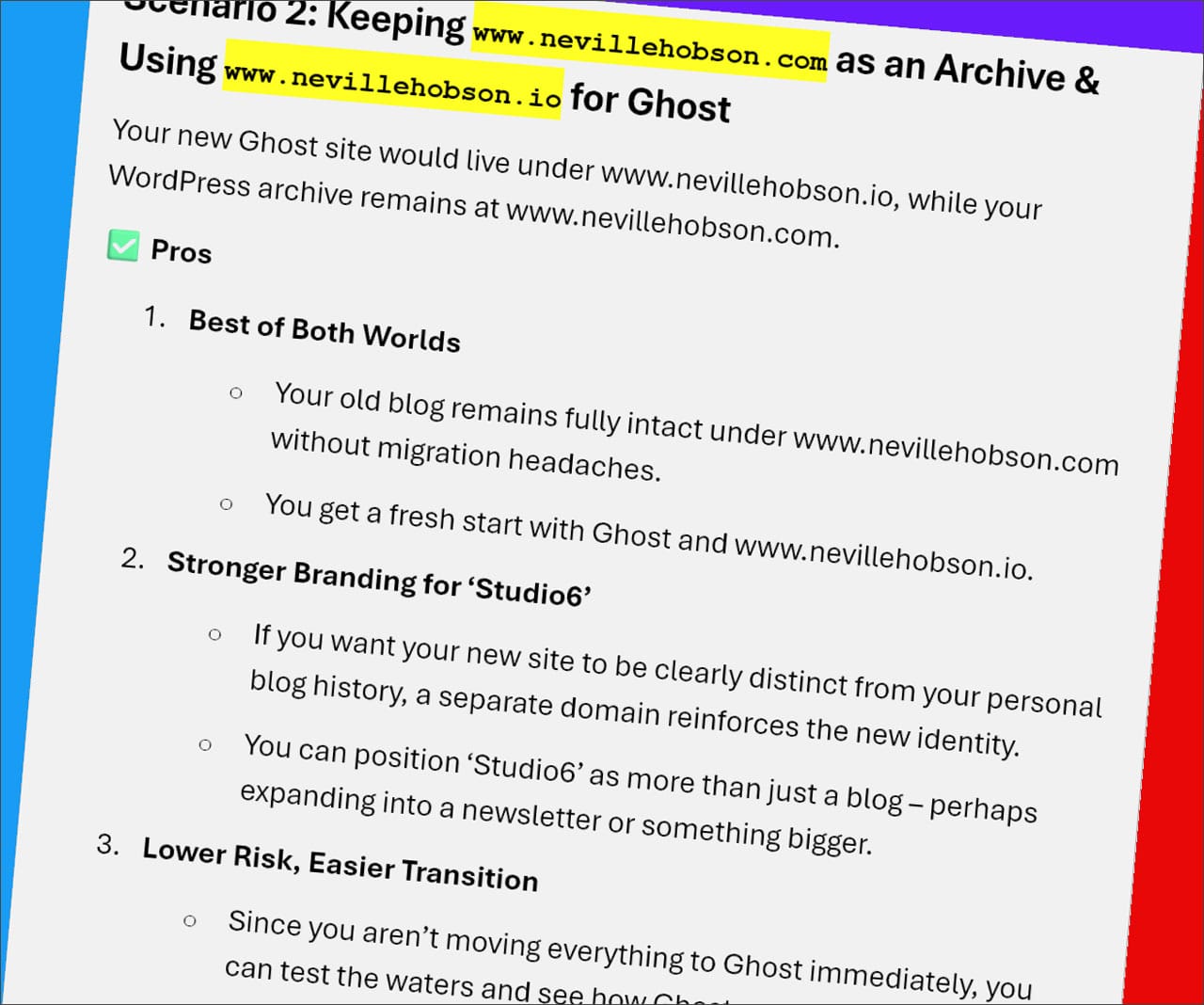
Looking ahead, I plan to fully leverage Ghost’s built-in newsletter and subscription capabilities to try and deepen reader engagement and build stronger relationships. Additionally, I'm exploring ways to enhance content discoverability on nevillehobson.io, using Ghost’s native features to provide readers with relevant, high-quality experiences.
Ultimately, this fresh start marks not only a technical and administrative change but also a renewed commitment to clarity, authenticity, and meaningful content. I'm genuinely excited about the possibilities this new chapter brings, both for my readers and for my own growth as a writer and communicator.
Closing Thoughts and Resources
Deciding to move from WordPress to Ghost and launch nevillehobson.io has been an enlightening journey. It was never simply about switching technology – it was fundamentally about reclaiming the passion and authenticity of blogging and eschewing the falsehoods of manipulation by algorithms.
Almost three months after setting up my trial of Ghost Pro and then fully signing up, I am happy that I made that initial decision. I have learned a great deal already, and I am committed to developing my Ghost presence further. Plus I'm really excited about new things like ActivityPub.
While I've mentioned WordPress in the context of leaving it behind, I do want to say clearly that it is an excellent platform. With its open-source approach, it offered people the means (the free software and know-how) that made it easier than other prominent platforms at that time to start up a place on the Internet where you could share your thoughts with others and be part of the original blogosphere.
My enthusiasm for Ghost does need to be tempered a bit: what I have done isn't necessarily the best for everyone. There is a learning curve, especially if you come from a WordPress site with significant customisations and plugins for functionality outside the WordPress core. If you're used to the extreme ease of use in WordPress, with drag-and-drop features, plugins galore, and a huge ecosystem, your learning curve will steepen.
If you have a heavily customised theme, or multiple authors, that adds complexity. And if you have the quantity of posts I do on my now-archive site, that might present real challenges in migration.
Also, I should point out that a hosted Ghost Pro Creator account doesn't give you ready access to the server on which your site is hosted. This is the same as hosted WordPress. If you want that functionality, then self-hosted Ghost is likely your best option.
But, if you are looking at writing for people and not for manipulative algorithms – so SEO is not your driving force, whereas focusing on your writing is – then hosted Ghost could be a great choice for you.
So, if you are contemplating a similar change, my experience suggests that careful evaluation of your options, thoroughly examining the pros and cons of what you're planning to do, open-mindedness about new approaches (or going back to some old ones), and clarity of intent and purpose will steer you well on your journey.
Helpful resources if you're considering a similar move:
- Migrating from WordPress to Ghost: Official Guide
- Ghost Pro Hosting Options
- My post on Embracing Simplicity with Ghost
I read a few great reviews on others' experiences migrating from WordPress to Ghost that I found very helpful:
- Migrating from WordPress to Ghost: A Complete Guide by Runcloud, October 2024
- Notes from migrating 24 years of blog posts from Wordpress to Ghost by Matthew Haughey, February 2024
- My Review of the Ghost Blogging Platform after 1 year by Norbert Hires, September 2022
- The Haunting of One Man & His Blog by Adam Tinworth, April 2018
- Wordpress to Ghost by The Apiarist, undated
Lastly, my sincere thanks go to the Ghost Pro support team, whose excellent assistance gave me the confidence to do this, making my transition smoother and more manageable.
Have you made a similar move, or are you thinking about it? I’d love to hear about your experience – drop a comment below or by email, or connect with me via LinkedIn or Mastodon.





